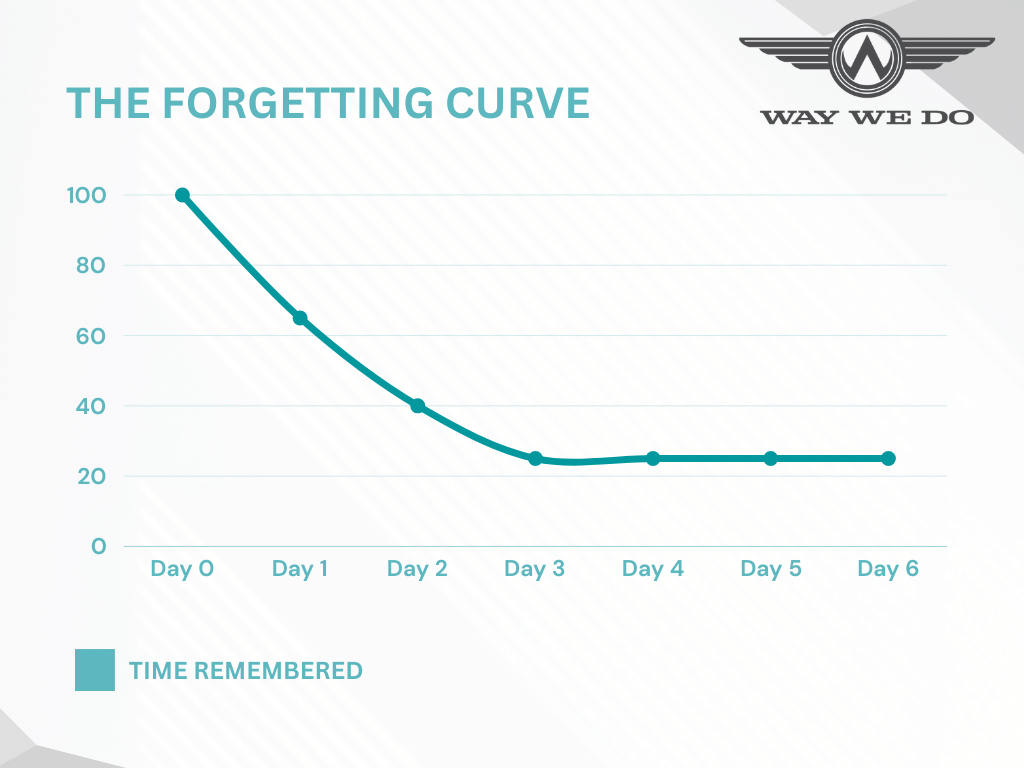In the fast-paced workplace environment, the challenge of retaining crucial information is magnified by the infamous Forgetting Curve, a concept first introduced by Hermann Ebbinghaus in the 1880s. This curve demonstrates how information is lost over time when no effort is made to retain it, with a significant drop in memory retention occurring just days after learning.
Traditional “point in time” training, often conducted in one-off sessions, is particularly susceptible to this effect, with employees quickly forgetting much of what they’ve learned. However, “just in time” training, supported by tools like Way We Do, offers a compelling solution to this challenge, reinforcing learning precisely when it’s needed in the workflow.
Understanding the Forgetting Curve in the Workplace
In workplace settings, training is frequently delivered at a single point in time, such as during onboarding or annual training sessions. While necessary, this method alone is not sufficient to ensure long-term retention and application of knowledge. The steep decline of the Forgetting Curve means that without reinforcement, the knowledge gained is likely to fade quickly, reducing the overall effectiveness of the training.
The Forgetting Curve suggests that memory retention declines exponentially over time unless the learned material is actively reviewed. The curve is steepest during the first 24 hours after learning, indicating that we forget the majority of new information quite quickly unless we take steps to reinforce it. The rate of forgetting can be influenced by factors such as the difficulty of the learned material, its meaningfulness, and the learner’s physiological state, among others.

“Just in Time” Training as a Solution
“Just in time” training addresses this problem by providing necessary information right at the moment it is needed. Unlike traditional training methods, this approach aligns learning with the immediate tasks at hand, thereby increasing relevance and retention. Here’s how Way We Do, a platform that integrates checklists and procedures into daily workflows (Activated Checklists), can be pivotal in implementing “just in time” training:
- Integration into Daily Workflows: Way We Do allows organizations to embed training directly into their operational processes. As employees engage with their regular tasks, they can access step-by-step instructions and training materials embedded within their workflow tools, ensuring they apply what they learn in real time.
- Reinforcement of Point in Time Training: “Just in time” training doesn’t replace traditional training sessions but rather enhances them. By providing reminders and access to key information when relevant tasks are performed, it reinforces the knowledge imparted during those initial training sessions, effectively combatting the Forgetting Curve.
- Customizable and Scalable: Way We Do’s platform is customizable to any workflow or process, making it scalable across departments. This flexibility ensures that as a company grows or changes, its training content can quickly adapt, always providing up-to-date information that supports immediate needs.
- Tracking and Feedback: With Way We Do, managers can track usage and engagement with the training materials, allowing them to identify areas where employees might need additional support. This feature enables a continuous improvement cycle of training content, ensuring it remains effective and relevant.
Sign up to a trial of Way We Do to try “just-in-time” training with Activated Checklist workflows.
Implementing “Just in Time” Training with Way We Do
To effectively implement “just in time” training in your organization, consider the following steps:
- Identify Key Processes and Tasks: Determine which tasks or processes can benefit most from “just in time” training. These are typically areas where mistakes are costly or common, where frequent updates in protocol occur, or where new tools are being introduced.
- Develop Integrated Training Materials: Create clear, concise training materials that can be directly integrated into Way We Do checklists or processes. Ensure these materials are easy to follow and accessible within the context of the tasks they relate to.
- Monitor and Adjust: Use the tracking tools provided by Way We Do to monitor how employees are interacting with the training materials. Collect feedback and use it to refine and improve the training content continuously.
- Reinforce with Reviews: Periodically, revisit the training materials in team meetings or through digital reminders. This reinforcement helps keep the knowledge fresh and top of mind.
Combating the Forgetting Curve in the workplace requires more than just one-time training sessions; it demands a strategic approach to ongoing education and reinforcement. By using “just in time” training via Way We Do, businesses can ensure that their employees not only retain crucial information but also apply it effectively when it matters most. This approach not only boosts productivity but also enhances employee confidence and competence, driving overall business success.





